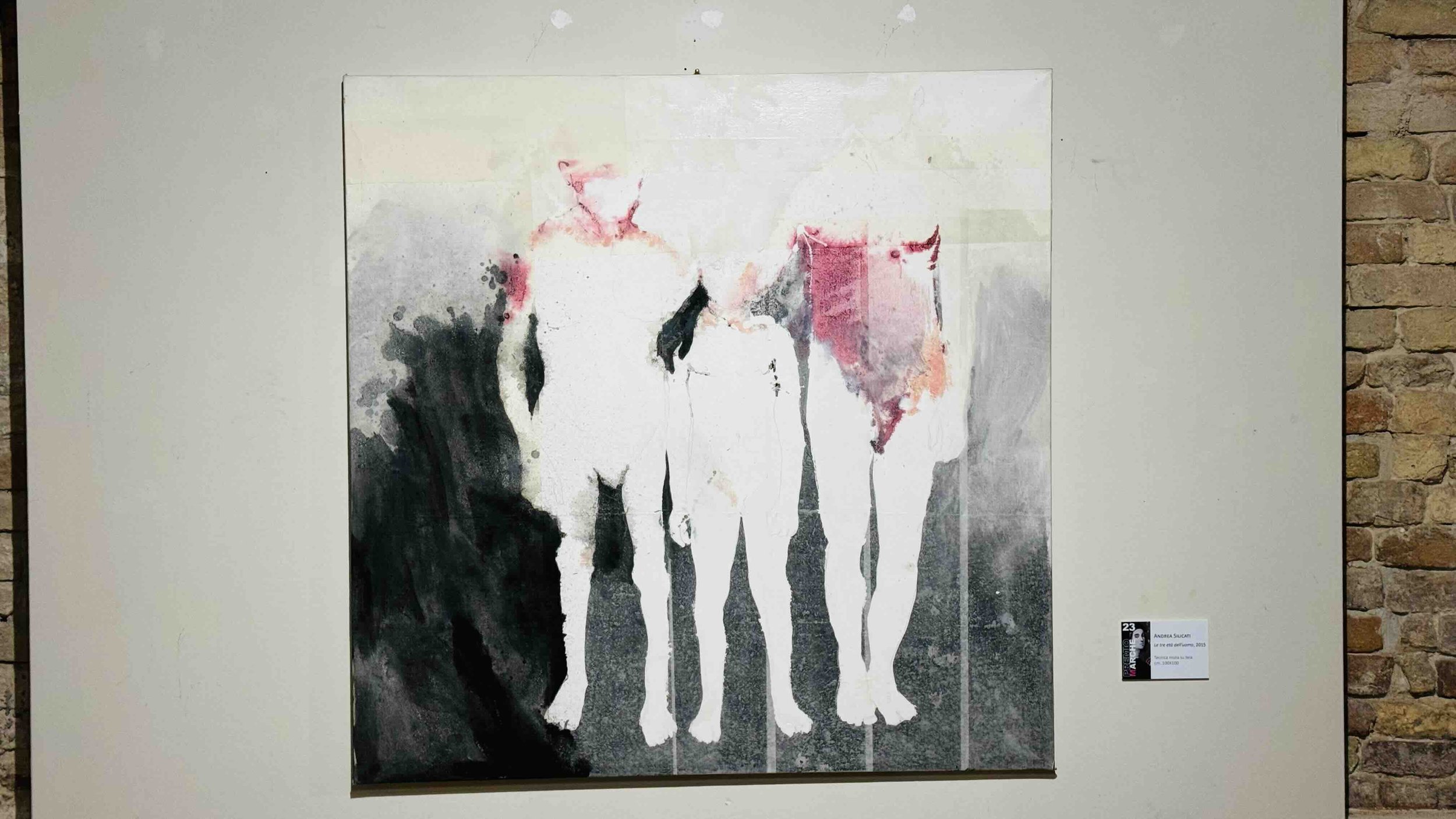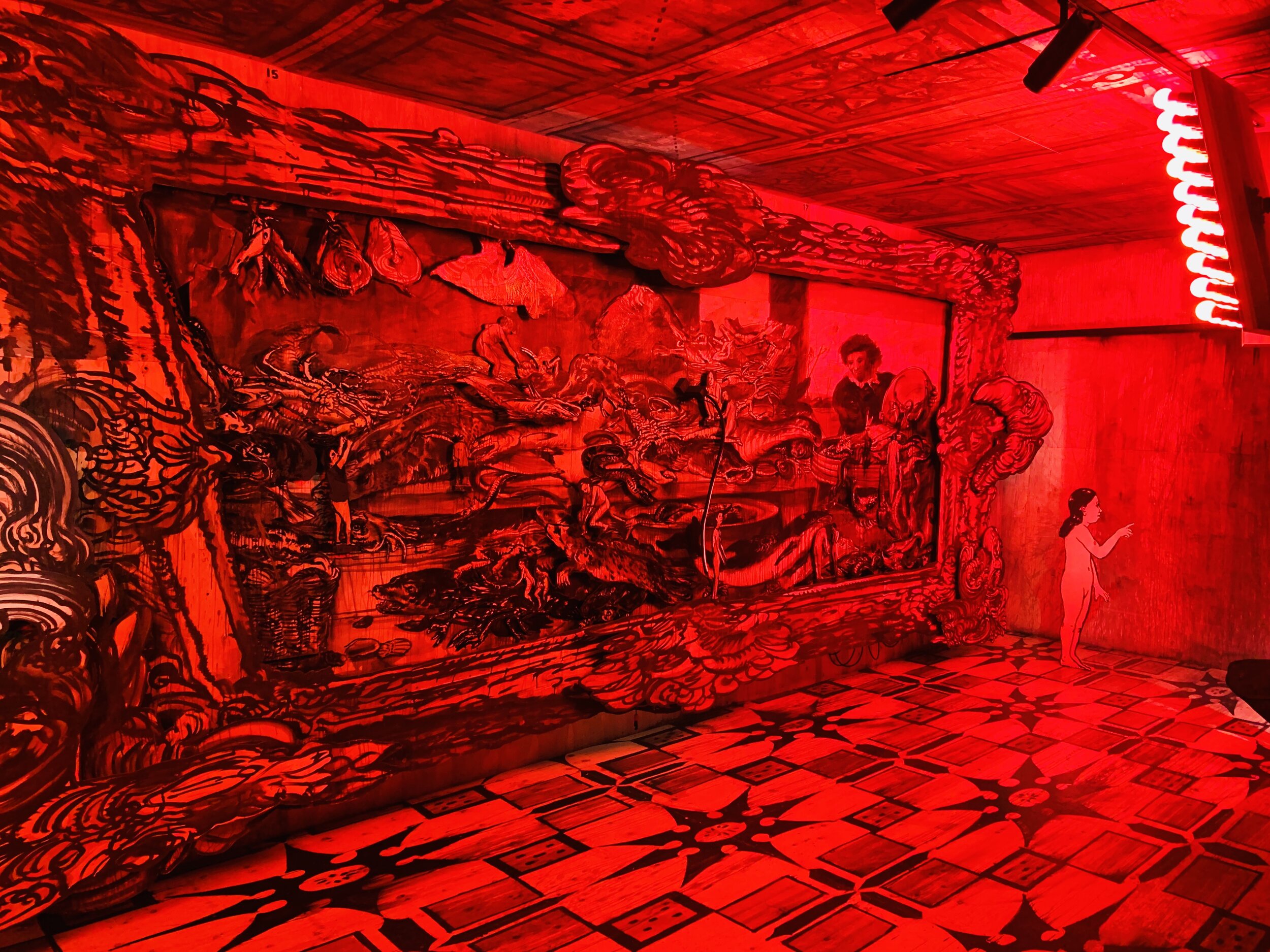Premio Marche 2023 “Under Raffaello” Rassegna di artisti italiani invitati 25.11.2023 – 3.03.2024 Albani Civic Art Gallery, Urbino
Simone Massi, Padre e figlio
Premio Marche 2023
“Under Raffaello”
Rassegna di artisti italiani invitati
25.11.2023 – 3.03.2024
Albani Civic Art Gallery, Urbino
Curator Camillo Langone
Credit photo: popcinema.org
Click Here for Italian Version
In the exhibition spaces of the Albani Civic Art Gallery in Urbino, "Under Raffaello", the contemporary art exposition of invited Italian artists, took place.
Obviously, the Urbino exhibition is named after its most illustrious fellow citizen, Raffaello Sanzio. Raphael's art was from Urbino. What other city could have given him so many masters? According to Vittorio Sgarbi, Urbino is just after Ferrara:
“And he was born in the most favourable place where a painter could be born after Ferrara: Urbino. Urbino is the city of Raphael, but in Urbino, there are no works by Raphael other than the one that Mussolini wanted to deposit there in 1927.” (1)
Possibly some of Raphael's art was also in Urbino, maybe inside the paintings of his father, the painter Giovanni Santi. Giorgio Vasari confirmed it in The Lives of the Artists:
"… As a result, not many years had passed before Raphael, still a young boy, was of great assistance to Giovanni in many works that he executed in the state of Urbino." (2)
Therefore, exploring the new cultural trends of Italian artists cannot be separated from the city of Urbino. The 2023 Marche Prize exhibition “Under Raffaello” is in its natural environment, both artistic and pictorial.
This is just an exhibition of paintings, in homage to Raphael, who was only a painter. Vittorio Sgarbi again:
“Raphael only painted. He was not a problematic man like Leonardo, a thinker curious about everything; he was not like Caravaggio, a "cursed man" living a life full of contrasts; he was not an artist like Michelangelo, painter, sculptor, poet, architect. … Raphael only painted. And every time he created a masterpiece. Painters, like his master Perugino, tend to repeat themselves, to reproduce a model, they have a reference archetype. Not him. Every time he invents a new image." (3)
The cultural validity of the exhibition is precisely in its title and in the apparently merciless comparison with emerging Italian artists with works created specifically or painted in the twelve months.
The curator, Camillo Langone, invited:
Dario Nani', Riccardo
Mattia Barbalaco (Vibo Valentia 1999),
Nicola Bindoni (Mirano VE 1999),
Chiara Calore (Abano Terme PD 1994),
Edoardo Cialfi (Marsciano PG 1993),
Erica Conti (Imola BO 1991),
Francesco De Prezzo (Lecce 1994),
Angela D’Ospina (Taranto 1987),
Giulia (Pasa) Frascari (Bologna 1992),
Rachele Frison (Desio MB 1995),
Leonardo Gambini (Ancona 1994),
Jacopo Ginanneschi (Castel del Piano GR 1987),
Miriana Lallo (Melfi PZ 1998),
Giulia Mangoni (Isola del Liri FR 1991),
Elisabetta Marino (Palermo 1989),
Elia Mauceri (Firenze 1987),
Matteo Messori (Reggio Emilia 1993),
Dario Nanì (Modica RG 1993),
Giulia Osella (Ivrea TO 1989),
Silvia Paci (Prato 1990),
Samuele Pigliapochi (Jesi AN 1987),
Nicola Vincenzo Piscopo (Napoli 1990),
Greta Pllana (Durazzo Albania 1992),
Davide Quartucci (Senigallia AN 2000),
Luca Rubegni (Roma 1993),
Domenico Ruccia (Terlizzi BA 1986),
Giuseppe Sciortino (Palermo 1988),
Lorenzo Tonda (Fiesole FI 1992),
Vittorio Valiante (Napoli 1991),
Giuseppe Vassallo (Palermo 1990),
Maria Giovanna Zanella (Schio VI 1991).
Tanti abile giovani.
Lorenzo Tonda, La casa di Asterione
There are many promising young people.
The favourite is Lorenzo Tonda's The House of Asterion. He re-proposes the myth with luminous hyperrealism. Asterion was born with a human body and a bull head. Locked up in a labyrinth, he is fed by Athens with nine boys and nine girls. Theseus kills him, freeing Athens from the tribute.
The Asterion of Tonda is not that of classical myth. His choice is deeper and more cerebral. Asterion is the protagonist of The House of Asterion's novel by Jorge Luis Borges. Asterion di Borges is weak, uncertain, melancholic, solitary, different: he is a monster. He talks to himself, accusing himself of:
“ … de soberbia, y tal vez de misantropía, y tal vez de locura.” (4)
“ ... arrogance, and perhaps misanthropy, and perhaps of madness.” (4)
For Tonda, Asterion sleeps on a bench in a messy position. The bull's head, with its immense horns, is detached. His face is half-hidden, and his feet are bare. The sunlight comes from behind, from a huge and perspective vault. Asterion is in the shade, covered with bamboo.
Jorge Luis Borges: “Es verdad que no salgo de mi casa, pero también es verdad que sus puertas (cuyo número es infinito ) están abiertas día y noche a los hombres y también a los animales.” (5)
Jorge Luis Borges: “It is true that I never leave my house, but it is also true that its doors (whose numbers are infinite) are open day and night to men and to animals as well.” (5)
Premio Marche 2023, under Raffaello
In fact, Asterion di Tonda is set outdoors. There are no walls or barriers. He wishes there were guardians, but there is just his depression.
Jorge Luis Borges: “No hallará pompas mujeriles aquí ni el bizarro aparato de los palacios, pero sí la quietud y la soledad.” (6)
Jorge Luis Borges: “He will find here no female pomp nor gallant court formality, but he will find quiet and solitude.” (6)
He is alone, abandoned, even his bull head appears detached. There is no luxury, but only a majestic arch.
Jorge Luis Borges: “Hasta mis detractores admiten que no hay un solo mueble en la casa.” (7)
Jorge Luis Borges: “Even my detractors admit there is not one single piece of
furniture in the house.” (7)
Tonda imposes a bench; fortunately, in the half-light, there is no furniture, no furnishings.
Jorge Luis Borges: “¿Repetiré que no hay una puerta cerrada, añadiré que no hay una cerradura?” (8)
Jorge Luis Borges: “Shall I repeat that there are no locked doors, shall I add that there are no locks?” (8)
There are no locks, there are no doors either, there is only an arch.
Jorge Luis Borges: “¿Lo creerás, Ariadna? -dijo Teseo-. El minotauro apenas se defendió.” (9)
Jorges Luis Borges: “Would you believe it, Ariadne?" said Theseus "The Minotaur scarcely defended himself.” (9)
Who knows, Asterion is not in a human posture, could already be dead? On the other hand, he died without defending himself to free himself from his sadness and loneliness. Was it a suicide?
Alongside the exhibition are the paintings of the winning artists of the 2022 Marche Prize, namely Renato Bertini, Marco Cingolani, Alessandro Gagliardini, Davide Monaldi, Emanuele Scorcelletti and Andrea Silicati. In particular, there are two descendants of the Pesaro territory. belong to different generations, but both have refined artistic skills: Simone Massi and Oscar Piattella.
From Pergola, with studies in Urbino, is Simone Massi. He has reached international authorial levels with a unique grace, style and language. His latest film, Invelle, had an exciting success at the 80th Venice Film Festival. Afterwards, the film toured the world, collecting awards and honours. His human qualities prevail over his artistic talents. Simone Massi has the ability to be the son of his land and like the other inhabitants, he is strong-willed, determined but continually humble. This is demonstrated by the beautiful Father and Son (Padre e figlio) presented in the exhibition. Black and white, but with a spot of red on the son's dress. They are behind, like Caspar David Friedrich's characters. Friedrich's human beings observe an unreal universe, perhaps irrational and unconscious visions. In Massi, father and son watch something real, tangible, material, a hard and tiring work, the Marche countryside.
Oscar Piattella, Senza titolo
Oscar Piattella lived in the province of Pesaro in Cantiano and graduated from Urbino University. He was the author of important exhibitions. He worked until his death in January 2023. His technique is form and time, drawing geometric lines with a refined use of colours.
Vasari is categorical; Raphael is superior to ordinary mortals:
“... as were seen in Raphael from Urbino are not simple mortals but (if it is permitted to speak in this way) mortal gods ..." (10)
In the “Under Raphael” exhibition, there are probably no gods but surely there are great artists, sons of the land of the Marche.
Vittorio Sgarbi, Raffaello Un Dio mortale, La nave di Teseo, Milano, I edizione, dicembre 2021, pag. 23. Translated by the author
Giorgio Vasari, The Lives of the Artists, Oxford University Press, page 306
Vittorio Sgarbi, Raffaello Un Dio mortale, La nave di Teseo, Milano, I edizione, dicembre 2021, pag. 14. Translated by the author
testo in spagnolo Jorge Luis Borges, La casa de Asterión (traduzione in italiano Jorge Luis Borges, L’Aleph, Milano, Feltrinelli, 1959) (traduzione in inglese Borges, Jorge Luis. 1964. The house of Asteron. In Labyrinths: Selected Stories and Other Writings, ed. Donald A. Yates and James E. Irby, London: Penguin. pp. 170-172)
testo in spagnolo Jorge Luis Borges, La casa de Asterión (traduzione in italiano Jorge Luis Borges, L’Aleph, Milano, Feltrinelli, 1959) (traduzione in inglese Borges, Jorge Luis. 1964. The house of Asteron. In Labyrinths: Selected Stories and Other Writings, ed. Donald A. Yates and James E. Irby, London: Penguin. pp. 170-172)
testo in spagnolo Jorge Luis Borges, La casa de Asterión (traduzione in italiano Jorge Luis Borges, L’Aleph, Milano, Feltrinelli, 1959) (traduzione in inglese Borges, Jorge Luis. 1964. The house of Asteron. In Labyrinths: Selected Stories and Other Writings, ed. Donald A. Yates and James E. Irby, London: Penguin. pp. 170-172)
testo in spagnolo Jorge Luis Borges, La casa de Asterión (traduzione in italiano Jorge Luis Borges, L’Aleph, Milano, Feltrinelli, 1959) (traduzione in inglese Borges, Jorge Luis. 1964. The house of Asteron. In Labyrinths: Selected Stories and Other Writings, ed. Donald A. Yates and James E. Irby, London: Penguin. pp. 170-172)
testo in spagnolo Jorge Luis Borges, La casa de Asterión (traduzione in italiano Jorge Luis Borges, L’Aleph, Milano, Feltrinelli, 1959) (traduzione in inglese Borges, Jorge Luis. 1964. The house of Asteron. In Labyrinths: Selected Stories and Other Writings, ed. Donald A. Yates and James E. Irby, London: Penguin. pp. 170-172)
testo in spagnolo Jorge Luis Borges, La casa de Asterión (traduzione in italiano Jorge Luis Borges, L’Aleph, Milano, Feltrinelli, 1959) (traduzione in inglese Borges, Jorge Luis. 1964. The house of Asteron. In Labyrinths: Selected Stories and Other Writings, ed. Donald A. Yates and James E. Irby, London: Penguin. pp. 170-172)
Giorgio Vasari, The Lives of the Artists, Oxford University Press, page 305






















The artworks in Italy are in an excessive number. The consequence is the invisibility of the majority of works preserved in museums.
The deposits in which they are kept are vast. This causes a problem with cataloguing and studying cultural heritage. Above all, it is unavailable to the public.
The Galleria Nazionale delle Marche in the Ducal Palace, Urbino, with the exhibition, The other collection. Stories and works from the deposits of the National Gallery of the Marche, offered the opportunity to see sixty paintings usually in the deposit.